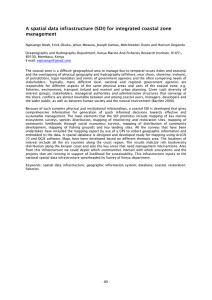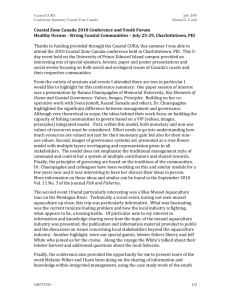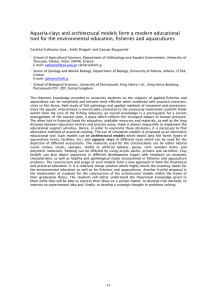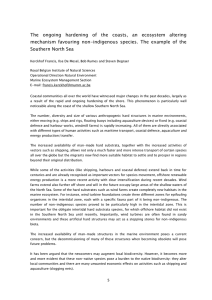TOWARDS SUSTAINABLE COEXISTENCE OF AQUACULTURE AND FISHERIES IN THE COASTAL ZONE
advertisement
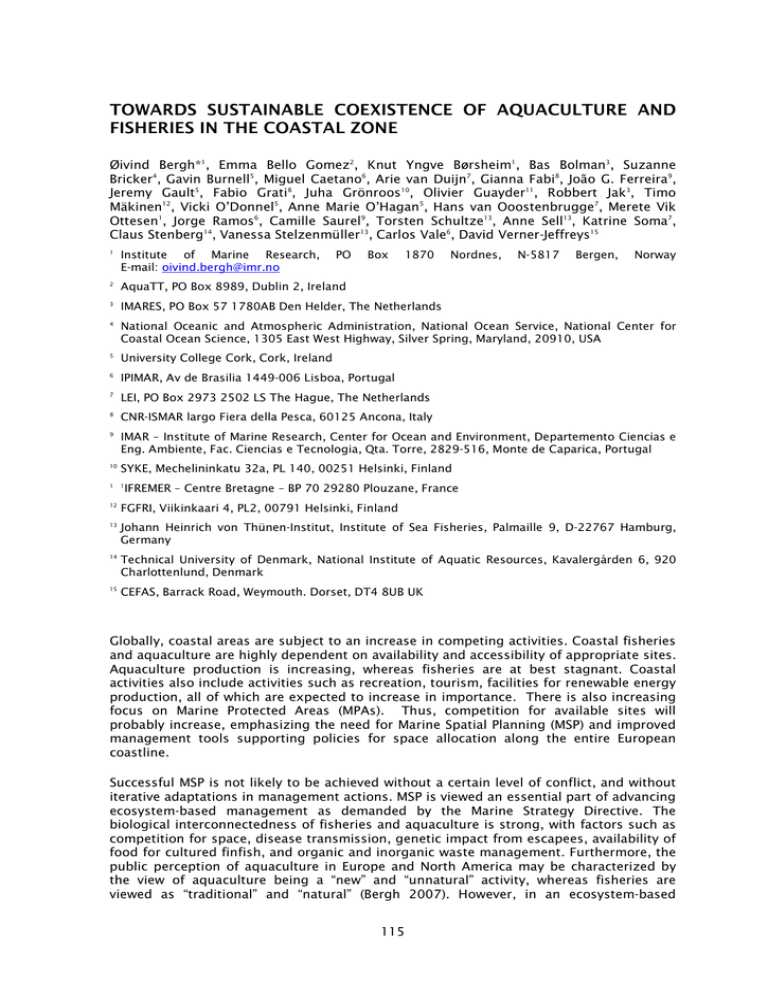
TOWARDS SUSTAINABLE COEXISTENCE OF AQUACULTURE AND FISHERIES IN THE COASTAL ZONE Øivind Bergh*1, Emma Bello Gomez2, Knut Yngve Børsheim1, Bas Bolman3, Suzanne Bricker4, Gavin Burnell5, Miguel Caetano6, Arie van Duijn7, Gianna Fabi8, João G. Ferreira9, Jeremy Gault5, Fabio Grati8, Juha Grönroos10, Olivier Guayder11, Robbert Jak3, Timo Mäkinen12, Vicki O’Donnel5, Anne Marie O’Hagan5, Hans van Ooostenbrugge7, Merete Vik Ottesen1, Jorge Ramos6, Camille Saurel9, Torsten Schultze13, Anne Sell13, Katrine Soma7, Claus Stenberg14, Vanessa Stelzenmüller13, Carlos Vale6, David Verner-Jeffreys15 1 Institute of Marine Research, E-mail: oivind.bergh@imr.no PO Box 1870 Nordnes, N-5817 Bergen, Norway 2 AquaTT, PO Box 8989, Dublin 2, Ireland 3 IMARES, PO Box 57 1780AB Den Helder, The Netherlands 4 National Oceanic and Atmospheric Administration, National Ocean Service, National Center for Coastal Ocean Science, 1305 East West Highway, Silver Spring, Maryland, 20910, USA 5 University College Cork, Cork, Ireland 6 IPIMAR, Av de Brasilia 1449-006 Lisboa, Portugal 7 LEI, PO Box 2973 2502 LS The Hague, The Netherlands 8 CNR-ISMAR largo Fiera della Pesca, 60125 Ancona, Italy 9 IMAR – Institute of Marine Research, Center for Ocean and Environment, Departemento Ciencias e Eng. Ambiente, Fac. Ciencias e Tecnologia, Qta. Torre, 2829-516, Monte de Caparica, Portugal 10 SYKE, Mechelininkatu 32a, PL 140, 00251 Helsinki, Finland 1 1 12 FGFRI, Viikinkaari 4, PL2, 00791 Helsinki, Finland 13 Johann Heinrich von Thünen-Institut, Institute of Sea Fisheries, Palmaille 9, D-22767 Hamburg, Germany 14 Technical University of Denmark, National Institute of Aquatic Resources, Kavalergården 6, 920 Charlottenlund, Denmark 15 CEFAS, Barrack Road, Weymouth. Dorset, DT4 8UB UK IFREMER – Centre Bretagne – BP 70 29280 Plouzane, France Globally, coastal areas are subject to an increase in competing activities. Coastal fisheries and aquaculture are highly dependent on availability and accessibility of appropriate sites. Aquaculture production is increasing, whereas fisheries are at best stagnant. Coastal activities also include activities such as recreation, tourism, facilities for renewable energy production, all of which are expected to increase in importance. There is also increasing focus on Marine Protected Areas (MPAs). Thus, competition for available sites will probably increase, emphasizing the need for Marine Spatial Planning (MSP) and improved management tools supporting policies for space allocation along the entire European coastline. Successful MSP is not likely to be achieved without a certain level of conflict, and without iterative adaptations in management actions. MSP is viewed an essential part of advancing ecosystem-based management as demanded by the Marine Strategy Directive. The biological interconnectedness of fisheries and aquaculture is strong, with factors such as competition for space, disease transmission, genetic impact from escapees, availability of food for cultured finfish, and organic and inorganic waste management. Furthermore, the public perception of aquaculture in Europe and North America may be characterized by the view of aquaculture being a “new” and “unnatural” activity, whereas fisheries are viewed as “traditional” and “natural” (Bergh 2007). However, in an ecosystem-based 115 management context, both industries represent human activities strongly influencing, and influenced by, the environment. Depending on where and how marine spatial management is applied it can have dissimilar impacts on the natural, economical and social environments (Pascoe et al. 2009) Conflicts between different activities could hamper development. In Europe, annual growth of aquaculture has declined to 1%. This is partly because of market factors, but also because the industry is subject to stringent regulation and sustainable development is a major condition. This means that the bulk of the projected thirty million tonnes of additional aquatic products needed to feed the planet by the year 2050, when the world population is expected to reach nine billion, will be cultivated outside Europe (Ferreira 2012) Management of aquaculture and fisheries, as well as other uses of the coastal zone, should be considered integral parts with local variations in their respective importance. Since different activities advance towards dissent economic, environmental and sociocultural objectives, conflicts occur when these multi-dimensional activities collide, according to different spatial contexts and institutional settings. The COEXIST project aims at outlining a process which avoids unnecessary conflicts or even enhances mutual benefits between different activities in the coastal zone. By means of using a transparent approach based on multi-criteria analysis (MCA), we characterize and establish priorities of future development and/or conservation in coastal areas. MCA is a useful technique to incorporate stakeholder preferences when evaluating marine spatial management and propose improvements (Soma 2010) Data are obtained from enquiring different groups of stakeholders in six different case studies from Europe’s coastal zone, representing different complexity, and different natural and social conditions. By definition, aquaculture implies rearing large numbers of animals of the same species in limited space. This favours the establishment and proliferation of pathogens, i.e. viruses, bacteria and parasites capable of exploiting the reared animals as hosts (Krkosek 2011). Diseases can be spread from wild to farmed animals and vice versa, emphasizing the importance of limiting the potential of such transfers (Johansen et al. 2011). Pathogens may be spread by wild organisms, escapees from aquaculture, transport of cultured organisms, transport of equipment or people, ballast water from ships or water currents. We are investigating how disease interactions particularly affect the aquaculture activities - and the environment - in contrasting case studies. Models are used to review and analyse pathogen transmission and spreading (Murray 2009) are applied, and strategies for disease control, such as fallowing (Werkman et al. 2011), are investigated. By definition, fallowing, and control with area management are key issues. A possible development is a coherent and transparent management of larger areas or regions, in contrast to the individual farm-based management seen in most of Europe today. An aim of the project is to identify ways to adapt currently applied spatial management to integrate different forms of aquaculture and fisheries in the coastal zone, while taking into account other key users (e.g. tourism, wind farms, aggregate extraction, shipping) and future developments and exploiting mutual opportunities. Conflicts and synergies are equally important study areas, improvements should be sought through decreasing conflicts and increasing synergies. For each case study, the currently applied marine spatial management of coastal activities will be evaluated, and improvements proposed based on scenarios. The objectives are to: • • Evaluate the effectiveness of the currently applied marine spatial management of coastal activities in achieving aquaculture and fisheries specific objectives within the framework of sustainable development of coastal zones Evaluate the efficiency of the currently applied marine spatial management of coastal activities in achieving aquaculture and fisheries specific objectives within the framework of sustainable development of coastal zones 116 • • Evaluate adaptations to the currently applied marine spatial management and planning process in achieving aquaculture and fisheries specific objectives within the framework of sustainable development of coastal zones Propose improvements to the currently applied marine spatial management and planning process that will benefit the aquaculture and fisheries sectors specifically, and within the framework of sustainable development of coastal zones, limit the potential impact on other users as well as exploit mutual opportunities References Bergh Ø. 2007. The dual myths of the healthy wild fish and the unhealthy farmed fish. Diseases of Aquatic Organisms 75:169-174 Ferreira J.G., Saurel C., Nunes, J.P., Ramos, L., Lencart e Silva J.D., Vazquez F., Bergh Ø., Dewey, W., Pacheco A., Pinchot M., Ventura Soares C., Taylor N., Taylor W., VErner-Jeffreys D. 2012. Ria Formosa – POLIS LITORAL - -Plano P6: Plano de valorização e gestão sustentável das actividades ligadas aos recursos da Ria. Ria Formosa Polis Litoral/IMAR, in press. Johansen LH, Jensen I, Mikkelsen H, Bjørn PA, Jansen PA, Bergh Ø. 2011. Disease interaction and pathogens exchange between wild and farmed fish populations with special reference to Norway. Aquaculture 315:167-186. Krkosek M 2010. Host density thresholds and disease control for fisheries and aquaculture. Aquaculture Environment Interactions 1:21-32. Murray AG. 2009. Using simple models to review the application and implications of different approaches used to simulate transmission of pathogens among aquatic animals. Preventive Veterinary Medicine 88:167-177 Pasqcoe S., Bustamante R., Wilcoz C., Gibbs M. 2009. Spatial fisheries management: A framework for multi-objective qualitative assessment. Ocean and Coastal management 52(2):130-138. Soma K. 2010. Framing participation with multicriterion evaluations to support the management of complex environmental issues. Environmental Policy and Governance 20(2):89-106. Werkman M, Green DM, Murray AG, Turnbull JF 2011. The effectiveness of fallowing strategies in disease control in salmon aquaculture assessed with an SIS model. Preventive Veterinary Medicine 98:64-73. 117



